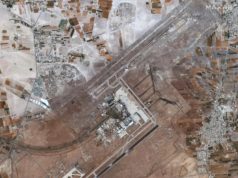“Syria has an integral role to play in reaching comprehensive peace,” said America’s Middle East envoy, George Mitchell, after “substantive discussions” in June with President Bashar al-Assad on ending hostilities with Israel.
Undoubtedly, genuine peace would be welcomed in the beleaguered Middle East. However, an Israeli-Syrian deal could backfire. It could re-arm Syria’s depleted military to the level of a regional power and force Jerusalem to relinquish the strategically vital Golan Heights, thereby diluting Israel’s qualitative military advantage, a key factor contributing to decades of quiet.
Surprisingly, the current “Cold War” status quo between Jerusalem and Damascus may be preferable to an agreement.
Since Syria and Egypt attacked Israel in the 1973 Yom Kippur War, political circumstances have isolated Damascus. While Syria maintains openly hostile to Israel, its allies have abandoned efforts to destroy the Jewish state. Egypt and Jordan signed peace treaties with Israel. Saddam Hussein’s Iraqi military was routed by the US in 2003. The recent Lebanese elections brought to power pro-Western forces. Thus, Syria would likely stand alone if it sought to strike Israel.
Jerusalem currently enjoys vast military superiority over the Syrians. This derives from its continued close relationship with America. For its part, Damascus is without a superpower patron since the Soviet Union’s demise in 1989.
In its current state, the Syrian military cannot mount a land invasion. Israel has the ability to destroy its armored combat vehicles both from the air and from the ground, notes retired Israeli general Giora Eiland. Israel also enjoys a tremendous advantage in the skies. The Syrian air force is at a dismal state of technical and operational readiness. Its defense system is antiquated, while Israel’s air capabilities have only strengthened.
Repeatedly, Israel has demonstrated its ability to operate at will in Syrian-controlled territory. In 2001, it destroyed a Syrian radar installation in Lebanon. In 2006, Israeli jets buzzed Assad’s palace, warning him against aiding Hamas. A year later, Israeli warplanes bombed a nearly-finished nuclear reactor in the Syrian Desert. In each instance, Syria did not respond.
Under a Syria-Israel peace agreement, President Assad could seek American military patronage to upgrade his armed forces. Indeed, Damascus might request hardware and training from the United States to narrow the qualitative military gap with Israel.
This is not merely speculation; there is a precedent. Egypt, after signing its treaty with Israel, did the same thing. Cairo receives roughly $2 billion in annual American aid under the 1979 agreement. Since 1979, the Egyptian army has improved its war-readiness. Up to 70% of the Egyptian military is equipped with Western weapons, including fighter jets and combat helicopters. Its armored divisions are outfitted with US-made tanks and precision anti-missile systems.
Thus, a Damascus-Jerusalem deal might actually increase the chance of war. Syria could improve its military capability through an aid package similar to what Egypt receives, elevating it to a regional power with the capacity to challenge Israel on the battlefield.
Moreover, an agreement with Syria would require Israel to relinquish control of the Golan Heights, a plateau overlooking Israel’s Hula Valley, which Israel captured in 1967. The Syrians used the Heights as a staging ground to bombard the Valley from 1948 through 1967.
The Golan is a hilly area with a rocky terrain. A high escarpment provides a vantage point over Damascus and the southern Syrian plain to the Golan’s east. In the northern part of the region sits Mount Hermon, the highest point in the area, from which Israeli radar stations monitor Syria troop movement. At the western edge of the Golan are rock cliffs that drop 1,700 feet, to the pre-1967 lines below.
Under a Syrian-Israeli agreement, the Golan would become demilitarized (just as the Egyptian treaty demilitarized the Sinai Peninsula.) Hence, war on Israel’s northern front would resemble a race, with Israel sprinting up the Heights to head off a Syrian attack. If Damascus launched a surprise strike on Israel, the topography is such that Syria would have a clear advantage in establishing dominance on the Golan’s high grounds.
General Eiland notes that thirty years of peace on the Egyptian border does not demonstrate a Syrian-Israeli deal’s utility. Even if-in a worse case scenario-Cairo re-oriented toward war, the Egyptian army is located on the Western side of the Sinai, 120 miles of flat terrain from the Israeli border. By contrast, if the Syrian regime breached a treaty with Israel, its military would have the ability to reach the Israeli border far quicker. The Golan is only 39 miles at its longest point.
The Israeli-Syrian status quo, in which the two sides maintain a Cold War-style quiet on their common border, remains the best option. While the reality is difficult to swallow, an agreement with Syria might allow the Assad regime to re-arm and gain a foothold atop the Golan, consequently moving the Middle East further away from peace.
Howard Gumnitzky studies international law at the University of Maryland.





